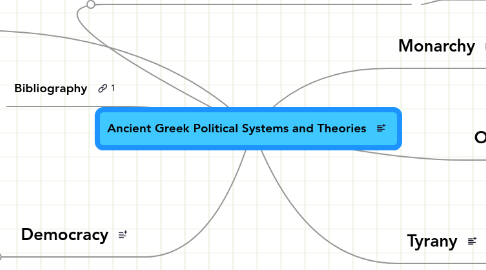
1. Democracy
1.1. Theory
1.2. Direct Democracy, Government of the People
1.3. Objective to Class
1.4. The Government for the Free
1.5. Structure of Democracy
1.5.1. Citizenship
1.5.2. Main Bodies of Governance
1.5.2.1. Assembly
1.5.2.1.1. Ekklesia
1.5.2.2. Courts
1.5.2.2.1. Suits and Jurries
1.5.2.3. Council
1.5.2.3.1. Boule
1.5.3. Particitpation
1.5.3.1. Officeholders
1.5.3.2. Citizen-initiator
1.5.4. Selection by Lot (Allotment)
1.5.4.1. Rotation of Jobs
1.5.5. Elected
1.5.6. Athenian Constitution
1.6. Pericles
1.7. Critisism of Democracy
2. The Archaic Period, 750-490 BCE
2.1. After Dark Age
3. Political Philosophers
3.1. Plato
3.1.1. The Republic, Book 8
3.1.1.1. Justice
3.1.1.1.1. A Three Part Soul
3.1.1.1.2. The Allegory of the Cave
3.1.1.1.3. Form of the Good
3.1.1.2. Disaggregation of Government
3.1.1.2.1. Timocracy
3.1.1.2.2. Oligarchy
3.1.1.2.3. Democracy
3.1.1.2.4. Tyranny
3.1.1.3. What The Republic Tells Today
3.1.1.3.1. View of Government Structure
3.2. Aristotle
3.2.1. Aristotle's Politics
3.2.1.1. Man and Justice
3.2.1.2. Household/State Relationships
3.2.1.3. Value of Goods and Exchange
3.2.2. View of Government Structure
4. Bibliography
5. Monarchy
5.1. Theory
5.2. The End of Monarchy
6. Oligarchy(Aristocracy)
6.1. Theory
6.2. The Aristocrats
6.2.1. Arête
6.2.2. Effect of Writing on Government and Aristocrats
6.2.3. Undermine of Power due to Change in Military, Unintentionally Paves the Way for Democracy
6.2.3.1. Preparation for Democracy
6.3. Government Change with the Emergence of the Greek Polis
7. Tyrany
7.1. Theory
7.2. Tyrants
7.2.1. Preparing for Democracy
7.2.2. The 30 Tyrants
